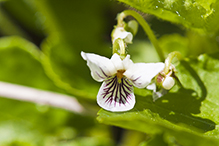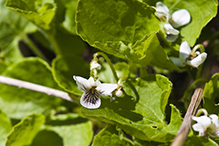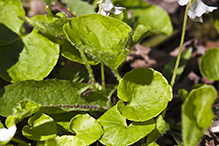kidney-leaved violet
(Viola renifolia)
Conservation • Wetland • Description • Habitat • Ecology • Use • Distribution • Taxonomy
Description |
||
Kidney-leaved violet is a 2″ to 4″ tall, erect, perennial forb that rises from an elongated, vertical rhizome. Unlike similar species, it does not produce above-ground creeping runners (stolons), or below-ground horizontal rhizomes. There is no central stem. The leaves are all basal, rising from the rootstock on 1″ to 6″ long leaf stalks (petioles). At the base of each petiole is a pair of leaf-like appendages (stipules). The stipules are ⅛″ to ⅜″ long, lance-shaped, and toothed. The leaf blades are kidney-shaped, rounded or blunt at the tip and heart-shaped at the base. They are ¾″ to 2⅜″ long and wide. The upper and lower surfaces may be hairy or hairless. Sometimes just the lower surface is hairy. The margins have rounded teeth. The inflorescence is one or more solitary flowers at the end of slender, leafless stalks rising from the rootstock. The flower stalks are usually shorter than the leaves. The flowers are ⅜″ to ⅝″ long. There are 5 white petals in an arrangement typical of violets, two upper, two lateral, and a broad lower lip. The lateral and lower petals have dark purple veins near the center. The lower petal has a short, rounded spur at the base. Either all of the petals have tufts of white hair near the center (bearded), or all do not. The fruit is an elliptical, purplish, ⅛″ to 3 ⁄16″ long capsule with brown seeds. |
||
Height |
||
2″ to 4″ |
||
Flower Color |
||
White with yellow centers |
||
Similar Species |
||
Western Canada violet (Viola canadensis var. rugulosa) is a larger plant, up to 16″ tall. It produces stolons. Flowers rise from the leaf axils of a leafy stem. The flowers are much larger, up to 1½″ wide. The petals are yellow near the center. The lateral petals are bearded, the upper and lower petals are not. The back side of at least the upper petals are purplish. Smooth white violet (Viola macloskeyi ssp. pallens) rises from a creeping, horizontal rhizome. It produces stolons. The leaves are heart-shaped or kidney-shaped at the base. The fruit capsule is green. Sweet white violet (Viola blanda var. blanda) rises from a creeping, horizontal rhizome. It produces stolons. The leaves are heart-shaped at the base. The upper petals are twisted and bent backward. The lateral petals are pushed forward. |
||
Habitat |
||
Cool or damp. Cedar swamps, woods, conifer thickets. |
||
Ecology |
||
Flowering |
||
May to July |
||
Pests and Diseases |
||
|
||
Use |
||
|
||
Distribution |
||||
|
Sources |
|||
| 3/22/2023 | ||||
Nativity |
||||
Native |
||||
Occurrence |
||||
|
||||
Taxonomy |
|||
| Kingdom | Plantae (Plants) | ||
| Subkingdom | Pteridobiotina | ||
| Phylum | Tracheophyta (Vascular Plants) | ||
| Class | Magnoliopsida (Dicots) | ||
Order |
Malpighiales (Nances, Willows, and Allies) | ||
Family |
Violaceae (violet) | ||
| Subfamily | Violoideae | ||
| Tribe | Violeae | ||
| Genus | Viola (violets) | ||
| Subgenus | Viola (pansies and violets) | ||
| Section | Plagiostigma | ||
| Subsection | Stolonosae | ||
Subordinate Taxa |
|||
|
|||
Synonyms |
|||
|
|||
Common Names |
|||
kidneyleaf white violet kidney-leaf white violet kidney-leaved violet kidney-leaved white violet northern white violet white violet |
|||
Glossary
Axil
The upper angle where the leaf stalk meets the stem.
Bearded
Bearing one or more tufts of hairs.
Petiole
On plants: The stalk of a leaf blade or a compound leaf that attaches it to the stem. On ants and wasps: The constricted first one or two segments of the rear part of the body.
Rhizome
A horizontal, usually underground stem. It serves as a reproductive structure, producing roots below and shoots above at the nodes.
Stipule
A small, leaf-like appendage at the base of a leaf stalk or flower stalk.
Stolon
An above-ground, creeping stem that grows along the ground and produces roots and sometimes new plants at its nodes. A runner.
Visitor Photos |
|||||
Share your photo of this plant. |
|||||
| This button not working for you? Simply email us at info@MinnesotaSeasons.com. Attach one or more photos and, if you like, a caption. |
|||||
|
|||||
MinnesotaSeasons.com Photos |
|||||
Flower |
|||||
 |
 |
||||
Leaves |
|||||
 |
|||||

Slideshows |
||

Visitor Videos |
|||
Share your video of this plant. |
|||
| This button not working for you? Simply email us at info@MinnesotaSeasons.com. Attach a video, a YouTube link, or a cloud storage link. |
|||
Other Videos |
|||

Visitor Videos |
|||
Share your video of this plant. |
|||
| This button not working for you? Simply email us at info@MinnesotaSeasons.com. Attach a video, a YouTube link, or a cloud storage link. |
|||
Other Videos |
|||

|
Created: Last Updated: © MinnesotaSeasons.com. All rights reserved. |
